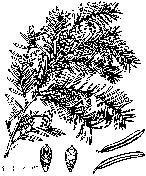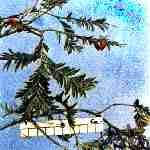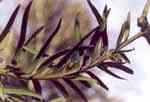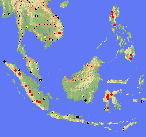Taxus sumatrana
(Miquel) de Laubenfels 1978
Common names
Tampinur batu [Karo, Malay]; kaju tadji [Mt. Dempo] (de Laubenfels 1988).
Taxonomic notes
Synonymy:
- Cephalotaxus sumatrana Miq. 1859;
- Podocarpus celebicus Hemsl. 1896;
- Cephalotaxus celebica Warb. 1900;
- Taxus celebica (O. Warburg) H.L. Li 1963;
The analysis by Hao et al. (2008) (see the Taxus discussion) placed T. sumatrana in a clade sister to T. mairei; T. sumatrana is the correct name if, like Eckenwalder (2009), you choose not to recognize T. mairei. Other authors (e.g. Farjon 2010) synonymize T. sumatrana with T. wallichiana. I here treat it as a distinct species on primarily biogeographical grounds; its distribution is disjunct from the other Asian species of Taxus and it is the only species in the genus to occupy fully tropical habitats.
Description
Evergreen shrub or tree to 14 m tall, wide and bushy when cultivated. "Leaves linear-lanceolate, falcate, spirally arranged, spreading in two ranks, about 1.2-2.7 cm. long, 2-2.5 mm. broad, abruptly pointed at the apex, the base decurrent, yellowish green above, pale green beneath. Seeds drupe-like, the fleshy arillate coat reddish at maturity, ripening in the first season (November). Trunk bark grayish red, with flimsy longitudinal commissure-like chinks, exfoliating in irregular flakes and leaving scars with dachytogram-like streaks on the trunk, flakes about 1.5 mm. thick; lenticels inconspicuous; outer bark about 0.4-1.6 mm., membranous or fibrous, with a reddish brown to orange yellow cross-section; phelloderm more or less conspicuous; inner bark 0.5-0.8 cm. thick, pink finely fibrous; freshly cut cambium and newly formed phloem colorless, transparent, becoming pale orange yellow after cutting. Freshly cut sapwood pale apricot yellow, wood rays inconspicuous" (Liu 1970 [as T. celebica]).
Distribution and Ecology
Sumatra, Philippines, Celebes at 1400-2300 m in moist subtropical forests, tropical highland ridges and moss forests in the subcanopy, locally dominant (de Laubenfels 1988). In the Philippines it occurs on high ridges and mountain summits in mossy forest, or sometimes in rocky grass and scrubland. In Sumatera and Sulawesi it is usually a mid-montane species (Thomas and Farjon 2011).
Distribution data for all species native to east Asia and Malesia, from Conifers of the World, downloaded on 2018.01.26.
The IUCN synonymizes this species with T. wallichiana and there has not been a formal conservation assessment for T. sumatrana, but the IUCN account states "In Viet Nam the subpopulation is limited to several hundred trees within a very limited area of Lam Dong Province. This remnant subpopulation was more extensive in the recent past but has declined due to deforestation and conversion of forests for agriculture. The status of Taxus populations in the Philippines and Indonesia is less clear. Some reports of exploitation associated with paclitaxel (taxol) production have come from the Philippines, but these have not been well documented. Although the Philippines has lost the vast majority of its forest cover through logging and agricultural expansion, the degree to which this has affected Taxus is unknown and ground truthing of both recent and historic records is needed. In Sulawesi and Sumatera widespread deforestation has been concentrated in the lowlands rather than the montane areas where estimates of decline are as low as 5%. As with the Philippines further field work is required to ascertain the status of Taxus in these areas" (Thomas and Farjon 2011). Thus, an Endangered determination for T. sumatrana seems conservative and further study is needed.
Remarkable Specimens
De Laubenfels (1988) offers a photograph of a specimen photographed in 1933 on Mt. Bonthain, Celebes, that appears to be ca. 200 cm dbh.
Ethnobotany
No data as of 2023.02.23.
Observations
No data as of 2023.02.23.
Remarks
Citations
Hao da, C., B. Huang, and L. Yang. 2008. Phylogenetic relationships of the genus Taxus inferred from chloroplast intergenic spacer and nuclear coding DNA. Biol Pharm Bull 31:260–265.
Thomas, P. and A. Farjon. 2011. Taxus wallichiana. The IUCN Red List of Threatened Species 2011: e.T46171879A9730085. https://www.iucnredlist.org/details/46171879/0, accessed 2018.02.13.
See also





